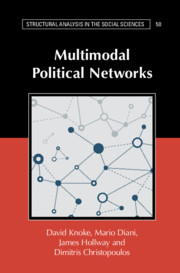Book contents
- Frontmatter
- Contents
- Figures
- Tables
- Preface
- 1 Politics, Communities, and Power
- 2 Multimodal Graphs and Matrices
- 3 Agency, Influence, Power
- 4 Political Communities in a Policy Network
- 5 Individuals in Associations
- 6 Agents and Events in Collective Action Fields
- 7 Nations Trading and Fighting
- 8 Legislative Influence
- 9 The Potential of Multimodal Political Networks
- Appendices
- References
- Index
8 - Legislative Influence
Published online by Cambridge University Press: 12 May 2021
- Frontmatter
- Contents
- Figures
- Tables
- Preface
- 1 Politics, Communities, and Power
- 2 Multimodal Graphs and Matrices
- 3 Agency, Influence, Power
- 4 Political Communities in a Policy Network
- 5 Individuals in Associations
- 6 Agents and Events in Collective Action Fields
- 7 Nations Trading and Fighting
- 8 Legislative Influence
- 9 The Potential of Multimodal Political Networks
- Appendices
- References
- Index
Summary
Chapter 8 investigates legislative influence. We analyze US senators’ voting on bills in the 112th Congress and campaign contributions senators received from PACs. Optimal modularity analysis identifies communities by maximizing densities of ties within communities. It finds great polarization between Republican and Democratic senators, their campaign financiers, and their legislative voting agendas. The core-periphery model finds that the core and peripheral communities are both heterogeneous mixtures of senatorial partisan affiliations, funding sources, and voting decisions. The affiliated graph model allows some entities to belong to more than one community and others to none. On balance, the AGM result provide a more plausible and nuanced depiction of the complex nexus between political money and legislative voting. Each community contains almost all the senators of one political party, their PAC funders, and their preferred legislative bills. But, both communities exhibit heterogenous mixtures of entities due to a substantial dual-community component comprising subsets of the three entities. The AGM approach strongly supports a research hypothesis that US legislative communities are divided into two bipartisan camps. However, a subgroup of entities belonging to both communities has the structural potential to play a power brokerage, or go-between, role.
- Type
- Chapter
- Information
- Multimodal Political Networks , pp. 180 - 196Publisher: Cambridge University PressPrint publication year: 2021



